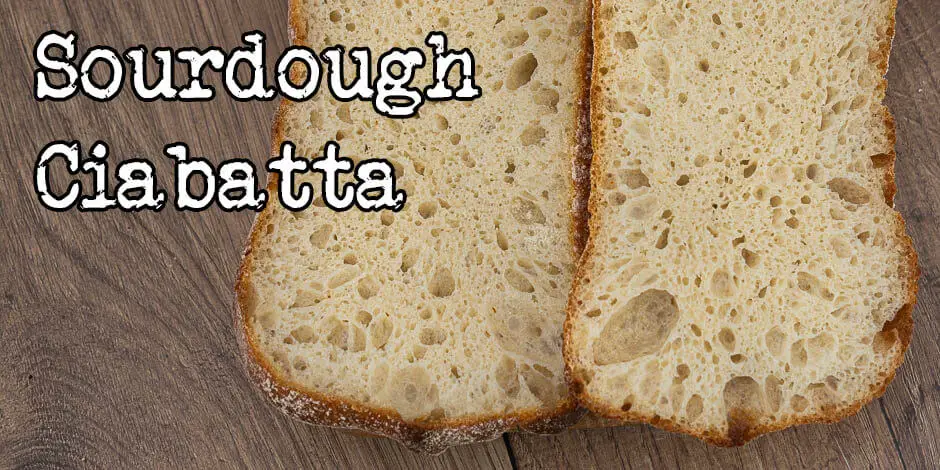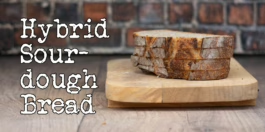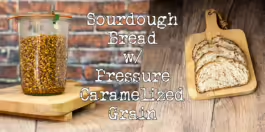You’re in the mood for a perfect sandwich. Bread-wise, there are so many different types of bread. Regular sourdough bread, french baguette, rye bread. The possibilities are endless. Then you think about a ciabatta. Oh yes, ciabatta. This is my sourdough ciabatta recipe.
If you are just here for the recipe, you can press the button underneath to be automagically transported to the recipe:
Jump to Recipe Jump to VideoThe history of ciabatta
While many people think that ciabatta is an old recipe going hundreds of years back, the truth is that it was invented in 1982.
Italian bakers were worried that the popularity of the french baguettes would hurt Italian businesses, so a miller and baker named Arnaldo Cavallari created the ciabatta. One of the points was that it would be appropriate for sandwiches.
He experimented for a few weeks and settled on a soft dough made with high-gluten flour.
This bread was licensed to Cavellari’s company and was licensed to 11 countries by 1999. Today ciabatta is well-known all over the world.
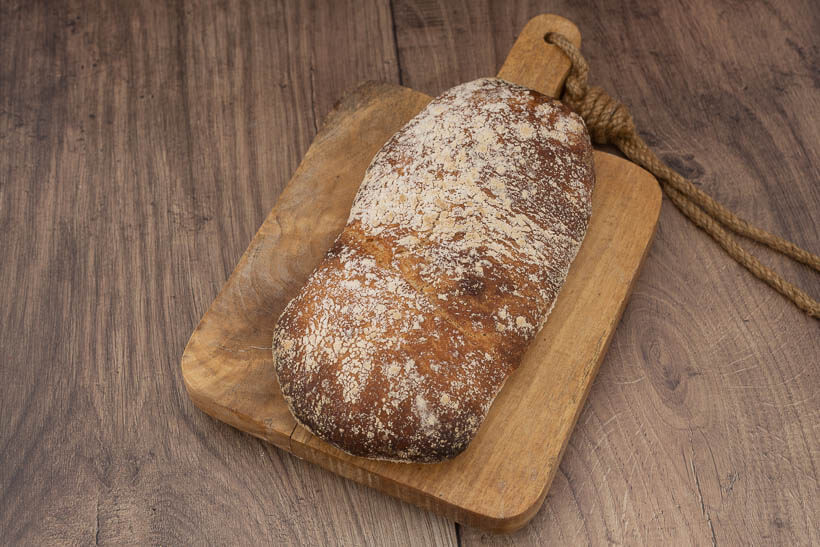
The composition of the dough in this sourdough ciabatta recipe
Vitals
| Total weight | 800 grams |
| Pre-fermented flour | 9.1% |
| Hydration | 90% |
| Yield | 2 small ciabatta |
The dough
A normal ciabatta is white bread, so we only use bread flour. I am using an Italian flour called Caputo Manitoba Oro.
The hydration is very high at 90%, which is essential for the result.
The salt content is slightly over 2%, and the inoculation is 20%.
Some olive oil is added for extra extensibility and extra self-life.
| Weight | Ingredient | Baker's Percentage |
|---|---|---|
| 368g | bread flour | 100% |
| 327g | water | 88.9% |
| 74g | starter (100% hydration) | 20.1% |
| 23g | olive oil | 6.3% |
| 8g | salt | 2.2% |
If you want to play around with the recipe: change hydration and quantity, or add some whole grain, you can do so in my Bread Calculator.
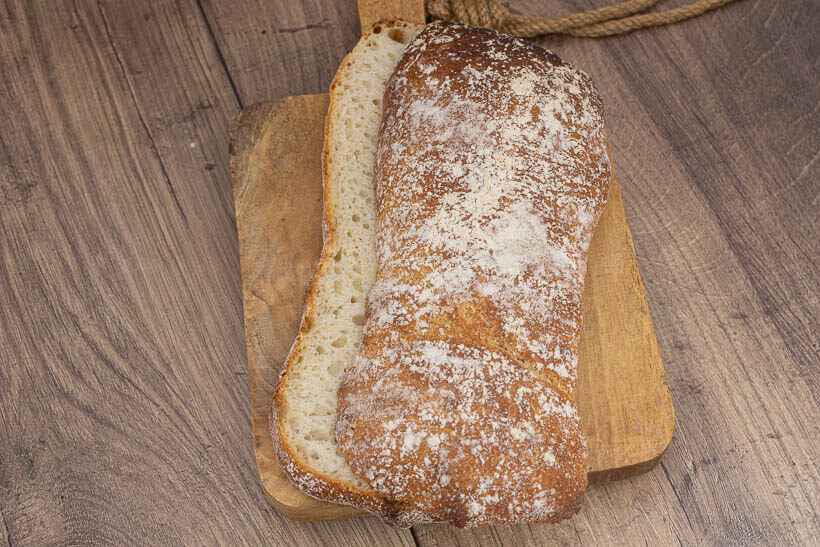
The conclusion of this sourdough ciabatta recipe
So what do you look for in a ciabatta?
- Long and relatively flat, perfect for
- Holey crumb
- Soft crust and crumb
- For the perfect look, it needs to be well floured
- A wonderful and well-developed flavor
So how does this bread stack up?
It delivers on all parameters. It’s perfect for sandwiches, for just plain eating, and for dipping in a gorgeous extra virgin olive oil.
You should try and make this bread. It’s awesome. Make sure you have some very strong flour, though.
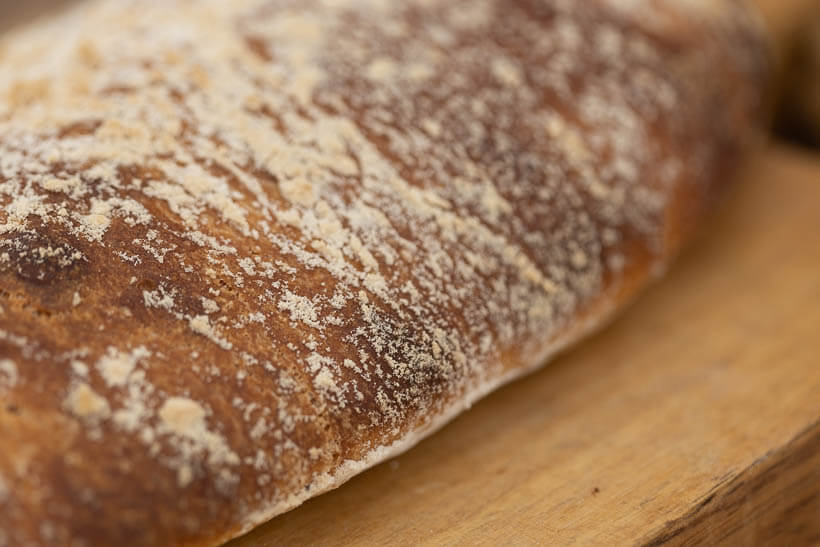
Please share this recipe for sourdough ciabatta bread on social media
This is my recipe for artisan sourdough bread. If you like the recipe, please consider sharing it with like-minded bread lovers on social media.
If you make it and post it on Instagram, please tag me as @foodgeek.dk so I can see it. That would make me very happy.
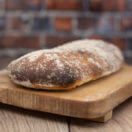
Sourdough Ciabatta
Ingredients
- 368 g bread flour 14% protein or above
- 8 g salt
- 74 g sourdough starter fed and grown to its peak
- 327 g water
- 23 g extra virgin olive oil
Instructions
Mix dough
- To a bowl add: 368g strong bread flour and 8g salt.
- Mix it up.
- Then add: 74g starter and 327g water.
- Combine everything until all the flour has been hydrated.
- Then add 23g extra virgin olive oil on top of the dough.
- Leave the dough to rest for an hour.
Slap and fold the dough
- Mix the dough to incorporate the oil.
- Pour the dough out onto the kitchen counter and perform slap and folds. Enough until you feel like the dough is coming together.
- Cover the dough and let it rest for 30 minutes.
Perform two coil folds
- Then perform a coil fold. Let the dough rest for 30 minutes.
- Perform another coil fold.
Let the dough rise
- Then move the dough to a bulking container and let it grow by about 25%.
- It took about 3 hours for my dough to grow in my proofer set to 30 degrees Celsius/86 degrees Fahrenheit.
- Then grab the dough and put it in the fridge to retard for at least 8 hours, up to 48 hours.
Bake the bread
- When you are ready to bake, heat your oven to 250°C/480°F, with a baking steel and a small pan inside used to create steam.
- When the oven is hot, boil a kettle of water.
- Flour your counter liberally. Turn your bulking container upside down and let the dough come out.
- Flour the top of the dough. Again liberally.
- Divide the dough into two equally sized pieces.
- Tug the sides with your bench scraper to shape it into a rounded rectangle.
- Then move the doughs to a parchment-lined peel. If your peel isn’t big enough, you’ll have to do it over two times.
- You might want to dust it with more flour if some of it gets absorbed while shaping. Then move the doughs to the oven.
- Pour a kettle of water into the small pan. Close the oven and bake for 20 minutes.
- Then remove the steaming pan and lower the heat to 200 degrees Celsius/390 degrees Fahrenheit.
- Bake for another 10 minutes. When they are done, take them out of the oven and place them on a wire rack.
- Take them off the parchment paper and let them cool completely.



